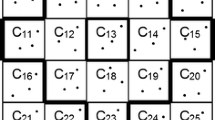Abstract
The intent of this paper is to propose an efficient approach of secure clustering in distributed sensor networks. The clusters or groups in the network are formed based on offline rank assignment and key-predistribution. Our approach uses the concept of weakly connected dominating set to reduce the number of cluster heads in the network. The formation of clusters in the network is secured as the secret keys are distributed and used in an efficient way to resist the inclusion of any hostile entity in the clusters. Along with the description of our mechanism, we present an analysis and comparison to justify the efficiency of our approach.
This work was supported by MIC and ITRC projects.
Preview
Unable to display preview. Download preview PDF.
Similar content being viewed by others
References
Carman, D.W., Kruss, P.S., Matt, B.J.: Constraints and Approaches for Distributed Sensor Network Security. NAI Labs Technical Report # 00-010, September 1 (2000)
Nowak, R.D.: Distributed EM ALgorithms for Density Estimation and Clustering in Sensor Networks. IEEE Transactions on Signal Processing 51(8), 2245–2253 (2003)
Halgamuge, M.N., Guru, S.M., Jennings, A.: Energy efficient cluster formation in wireless sensor networks. In: 10th International Conference on Telecommunications, 2003 (ICT 2003), February 23- March 1, vol. 2, pp. 1571–1576 (2003)
Lee, S., Yoo, J., Chung, T.: Distance-based energy efficient clustering for wireless sensor networks. In: 29th Annual IEEE International Conference on Local Computer Networks, November 16-18, vol. 2004, pp. 567–568 (2004)
Younis, O., Fahmy, S.: Distributed Clustering in Ad-hoc Sensor Networks: A Hybrid, Energy-Efficient Approach. IEEE Transactions on Mobile Computing 3(4), 366–379 (2004)
Ye, M., Li, C., Chen, G., Wu, J.: EECS: an energy efficient clustering scheme in wireless sensor networks. In: 24th IEEE International Performance, Computing, and Communications Conference (PCCC 2005), April 7-9, pp. 535–540 (2005)
Liu, J.-S., Lin, C.-H.R.: Power-efficiency clustering method with power-limit constraint for sensor networks. In: Proceedings of the 2003 IEEE International Performance, Computing, and Communications Conference, April 9-11, pp. 129–136 (2003)
Tzevelekas, L., Ziviani, A., Amorim, M.D.D., Todorova, P., Stavrakakis, I.: Towards potential-based clustering for wireless sensor networks. In: Proc. of the 2005 ACM conference on Emerging network experiment and technology, Toulouse, France, pp. 292–293 (2005)
Wokoma, I., Scks, L., Marshall, I.: Clustering n Sensor Networks using Quorum Sensing. In: The London Communications Symposium, University College London, September 8-9 (2003)
Banerjee, S., Khuller, S.: A clustering scheme for hierarchical control in multi-hop wireless networks. In: Proc. of the IEEE INFOCOM 2001, April 22-26, vol. 2, pp. 1028–1037 (2001)
Clark, B.N., Colbourn, C.J., Johnson, D.S.: Unit Disk Graphs. Discrete Mathematics 86, 165–177 (1990)
Garey, M.L., Johnson, D.S.: Computers and Intractability: A Guide to the Theory of NP-Completeness. W. H. Freeman, San Francisco (1979)
Das, B., Bharghavan, V.: Routing in ad-hoc networks using minumum connected dominating sets. In: Proc. IEEE International Conference on Communications (ICC 1997), pp. 376–380 (June 1997)
Erdos, Renyi: On Random Graphs. Publ. Math. Debrecen 6, 290–297 (1959)
Karlof, C., Wagner, D.: Secure routing in wireless sensor networks: Attacks and countermeasures. Elsevier’s Ad Hoc Network Journal, Special Issue on Sensor Network Applications and Protocols, 293–315 (September 2003)
Pathan, A.-S.K., Lee, H.-W., Hong, C.S.: Security in Wireless Sensor Networks: Issues and Challenges. In: Proc. of the 8th IEEE ICACT 2006, Phoenix Park, Korea, February 20-22, vol. II, pp. 1043–1048 (2006)
Gupta, G., Younis, M.: Load-balanced clustering of wireless sensor networks. In: IEEE International Conference on Communications (ICC 2003), May 11-15, vol. 3, pp. 1848–1852 (2003)
Author information
Authors and Affiliations
Editor information
Editors and Affiliations
Rights and permissions
Copyright information
© 2006 Springer-Verlag Berlin Heidelberg
About this paper
Cite this paper
Pathan, AS.K., Hong, C.S. (2006). A Key-Predistribution-Based Weakly Connected Dominating Set for Secure Clustering in DSN. In: Gerndt, M., Kranzlmüller, D. (eds) High Performance Computing and Communications. HPCC 2006. Lecture Notes in Computer Science, vol 4208. Springer, Berlin, Heidelberg. https://doi.org/10.1007/11847366_28
Download citation
DOI: https://doi.org/10.1007/11847366_28
Publisher Name: Springer, Berlin, Heidelberg
Print ISBN: 978-3-540-39368-9
Online ISBN: 978-3-540-39372-6
eBook Packages: Computer ScienceComputer Science (R0)




